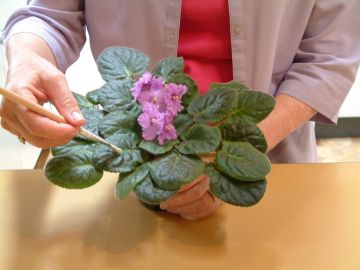Week 3: Three ways to indoor colour
So you love flowering plants but don't have
room (or time) for a garden? Well, the good
news is that some flowering plants flourish
indoors, and three of the best are cyclamens,
African violets and begonias.
Cyclamens
Cyclamens are winter performers that are
coming into their prime at this time of year.
They appreciate cool conditions, so make sure
they aren't left in heated rooms at night. It's a
good idea, too, to allow the plants dry out well
between waterings. Otherwise, the fat, flat
corm at the base of the plant will rot.
Feed your cyclamen occasionally with some
Thrive Concentrate Houseplant Food or a weak
solution of Thrive Flower & Fruit. Don't cut
dead flowers; pull them off by hand. The most
troublesome pest of cyclamens are mites.
These almost invisible creatures cause the
leaves to pucker, thicken and curl. If symptoms
occur, prevent further infestations by spraying
with Yates non-toxic Nature's Way Insect
Spray.
African violets
Although African violets are at their best in the
warmer months, they can be purchased in
flower at just about any time of year. They're
almost un-killable, but do need to be allowed to
rest between flower spurts. Feed with Thrive
Houseplant Food or Nature's Way Fish
Emulsion. Avoid watering over the leaves as
this can encourage the development of leaf
fungi (remove affected leaves at the first signs
of disease). Watch out for cyclamen mite
damage.
It's important to choose a favourable position
for African violets. They're happiest in bright
light near a window, but out of direct sunlight.
New African violets are easily propagated from
mature leaves. Pluck a healthy leaf, dip the
end of its stem in Yates Clonex and then push
into a pre-prepared hole in some Yates Black
Magic Seed Raising Mix. Half a dozen leaves
can go into the one pot. Eventually a new little
plant will start to form at the base of each leaf.
African violet leaves are covered with fine hairs
that are excellent dust catchers and a layer of
dust not only spoils the look of the plant, it
interferes with its function. Leaves can be
cleaned by brushing gently with a soft brush
(pictured).

Begonias
The large-flowered tuberous begonias are the
stars of the begonia group but, because they
prefer cool climates, in most areas 'Elatior'
begonias are a better choice. Elatior's a cross
between the summer-flowering tuberous
begonia and a winter-blooming African species.
This means it can come into flower at just about
any time of the year.
Elatior begonias are very prone to mildew so
water carefully (making sure that their leaves
stay dry), and protect the plants by occasionally
spraying with the fungicide Baycor. Yates Rose
Gun is another good option. As well as being
an effective fungicide, it has the advantage of
providing some protection from mites and insect
pests like caterpillars.
 Week
1 | Week 2
| Week 3 | Week
4| Product of the Month | Seed
of the Month
Week
1 | Week 2
| Week 3 | Week
4| Product of the Month | Seed
of the Month